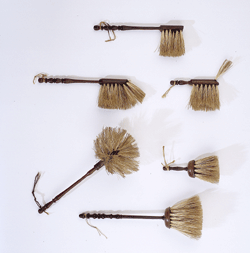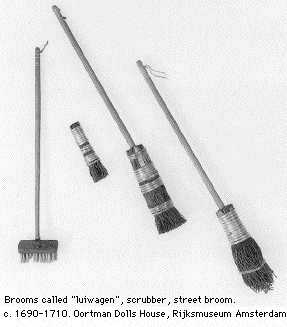 Cleaning
tools were not mentioned in the Vermeer inventory but they must have
been present in the house. These brooms and brushes were crafted by a
broom maker or schuyermaker.
Cleaning
tools were not mentioned in the Vermeer inventory but they must have
been present in the house. These brooms and brushes were crafted by a
broom maker or schuyermaker.
 Cleaning
tools were not mentioned in the Vermeer inventory but they must have
been present in the house. These brooms and brushes were crafted by a
broom maker or schuyermaker.
Cleaning
tools were not mentioned in the Vermeer inventory but they must have
been present in the house. These brooms and brushes were crafted by a
broom maker or schuyermaker.
Cleaning the house was among the chief tasks of a housewife. If there was enough money, the heaviest manual labour would be done by the maid or washerwoman. Houses and streets were kept scrupulously clean in the Dutch Republic. 'From morning to night no other thing was done but scrubbing, sweeping, dusting, scouring, washing and polishing and such matters..' (Pijzel Pronkpoppenhuis, 2000, p. 167).
Above: brushes from the Dunois Dolls House, Rijksmuseum, Amsterdam.
The traveller Ellis Veryard noted in 1701: "No people in Europe are so neat in their house; the meaner sort being extremely nice in setting them out to the best advantage. The women spend the greatest part of their time in washing, rubbing and scouring, that their pots and pans are kept brighter without than within. The floors of their lower rooms are commonly chequered black and white marble [sic!] and the walls and chimneys covered with a kind of painted tiles; their upper rooms are often washed and sprinkled with sand, to hinder any moisture from staining the boards. You had almost as good spit in a Dutch woman's face as her floor, and therefore there are little [=small] pots or pans to spit in." (Lit: C. Datema, 'British Travellers in Holland during the Stuart period. Edward Browne and John Locke as tourists in the United Provinces', Thesis, Vrije Universiteit, Amsterdam, 1989, p. 155.)
Personal hygiene was not considered as important; people did not wash very often.
 Note
: Note: Photo Copyright Rijksmuseum Foundation. The Rijksmuseum has
graciously assisted in this project Digital Home of Johannes
Vermeer. The author was given permission to make a selection in
the vast photo archive and this material has been made available by
the Rijksmuseum.
Note
: Note: Photo Copyright Rijksmuseum Foundation. The Rijksmuseum has
graciously assisted in this project Digital Home of Johannes
Vermeer. The author was given permission to make a selection in
the vast photo archive and this material has been made available by
the Rijksmuseum.
These objects were NOT part of the Vermeer-inventory as listed by the clerk working for Delft notary public J. van Veen. He made this list on February 29, 1676, in the Thins/Vermeer home located on Oude Langendijk on the corner of Molenpoort. The painter Johannes Vermeer had died there at the end of December 1675. His widow Catherina and their eleven children still lived there with her mother Maria Thins.
The transcription of the 1676 inventory, now in the Delft archives, is based upon its first full publication by A.J.J.M. van Peer, "Drie collecties...", Oud Holland, 1957, pp. 98-103. My additions and explanations are added in square brackets [__]. Dutch terms have been checked against the world's largest language dictionary, the Dictionary of the Dutch Language (Woordenboek der Nederlandsche Taal , or WNT), which was begun by De Vries en Te Winkel in 1882.
Illustrations taken from the handbook on Dutch Doll Houses by Jet Pijzel-Dommisse, 'Het Hollandse pronkpoppenhuis, Interieur en huishouden in de 17de en 18de eeuw', Waanders, Zwolle and Rijksmuseum, Amsterdam, 2000, ill. 288, 292.
This page forms part of a large encyclopedic site on Vermeer and Delft. Research by Drs. Kees Kaldenbach (email). A full presentation is on view at johannesvermeer.info.
Launched December, 2002; Last update March 2, 2017.
Back to the Welcome page: click Welcome.